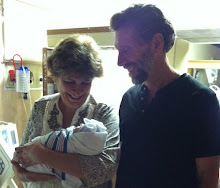I take a large bowl out of the cupboard, a bag of flour off the shelf, some salt, a little sugar, some oil, yeast. I turn the tap to it's warmest setting and let the water flow until it is hot to the touch. I begin to mix. Some yeast, the water, a little sugar. I wait and watch as the yeast begins to move and mix and grow. Into the flour and oil and salt it goes, making a thick, soupy mass of goop. I add more flour and then more still until the goop becomes a glistening ball of dough, slightly elastic to the touch, warm and smelling yeasty. Into another bowl it goes, slick with oil top and bottom, to sit and grow undisturbed, covered by a clean towel to keep the drafts away and the warmth in. When I look again it has grown anew, the top blistered with bubbles of yeast, it begs to be punched down and divided into loaves. I knead it and shape it and form it into loaves the size of the bread pans. I lay each loaf in it's own pan, making sure that the ends are supported by the ends of the pan, I cover it and wait again. In a while, I turn on the oven and the kitchen grows warm with the heat. When the oven is warm enough, the loaves raised enough, the time long enough, I place the pans on the oven rack and close the oven door. Soon, the smell of fresh bread makes it's way through the house. When it is time I open the oven door and remove the lovely bread. It is hollow to my tap, the crust brown and ready for a brush of butter across it's expanse. It falls effortlessly from the pan when I turn it over and I place the loaves on a rack to cool. Before they are ready to be wrapped someone takes a knife from the drawer and cuts off one end, butters the slice, a little jelly, and before I know it one loaf is half gone as my family comes in and samples the fresh bread. Before the week is over the bread will be toasted for breakfast, sliced and grilled with cheese, a sandwich for roast beef and lettuce with cheese, a bedtime snack. It will barely last long enough for Sunday dinner when some will be broiled with tomato and mozzarella cheese, fresh herbs and olive oil drizzled over it, and served with the pasta.
When I was young we would often visit my father's aunts. He had seven of them, all sisters of his mother, who had died when he was 2. So the Aunts were his surrogate mom's, a veritable army of love and solicitous adoration. My Aunt Fanny would cut paper dolls from newspaper in long strings that always amazed us. How did they stay together? My Aunt Vicki would always be ready to make you a hamburger, no matter the time of day or the day of the week. Her house always smelled like hamburgers and big fat french fries, cut fresh and piping hot from the oil. My Aunt Adele was the bread baker. My grandfather and his sisters had come here from Lebanon where they lived in a tiny mountain town. In the United States they migrated west and ended up in the mountains of Colorado. Eventually, Adele moved south to New Mexico, where she could still see the mountains surrounding Albuquerque. We would visit there often for she was a favorite aunt. Each Saturday at my Aunt Adele's was baking day. She would awaken early and the ritual began, a large bowl, some yeast, a huge bag of flour, oil, salt and sugar. But this bread was different than my high loaves. She would prepare the dough, let it rise, and then break it into eight or ten small pieces. Each piece would become a round, flat loaf. When it had rested she would take the small piece of dough and begin to pull it and stretch it, as it grew bigger she would toss it across one forearm and then the other until it was a big, flat disc. She would lay it on the hot rack of the oven and in only a couple minutes the bread would be done on one side and turned. She would work at this all morning, piling the loaves on a clean towel on the floor until eventually the stack would be above the counter. Of course if you were lucky enough to be there you could grab a loaf and run off with it, pulling it apart and gulping it down, as you ran. If you were more patient Aunt Adele would take a piece still warm and drench it with butter that would drip off the edges of the bread and down your arms as you ate it. When she had finished her bread making, usually about 100 loaves in a morning, she would package the bread for her three sons and their families and we would deliver it to them. And the ritual was the same.
This ritual, repeated every week or two, month in and month out, for years marks the rhythms of our family as it grows and changes. And yet the ritual of the bread baking remains the same, a little flour, a bowl, some yeast, oil, sugar, salt and hot water. Sometimes some cinnamon, or milk instead of water, but basically no change. The yeast grows, the bread rises, the heat bakes it. There is no culture that does not have a bread recipe handed down from one mother to her daughter, or father to son. In the simple ritual of bread making I reach back in time to other people, and other cultures. All of us continuing the ritual.
